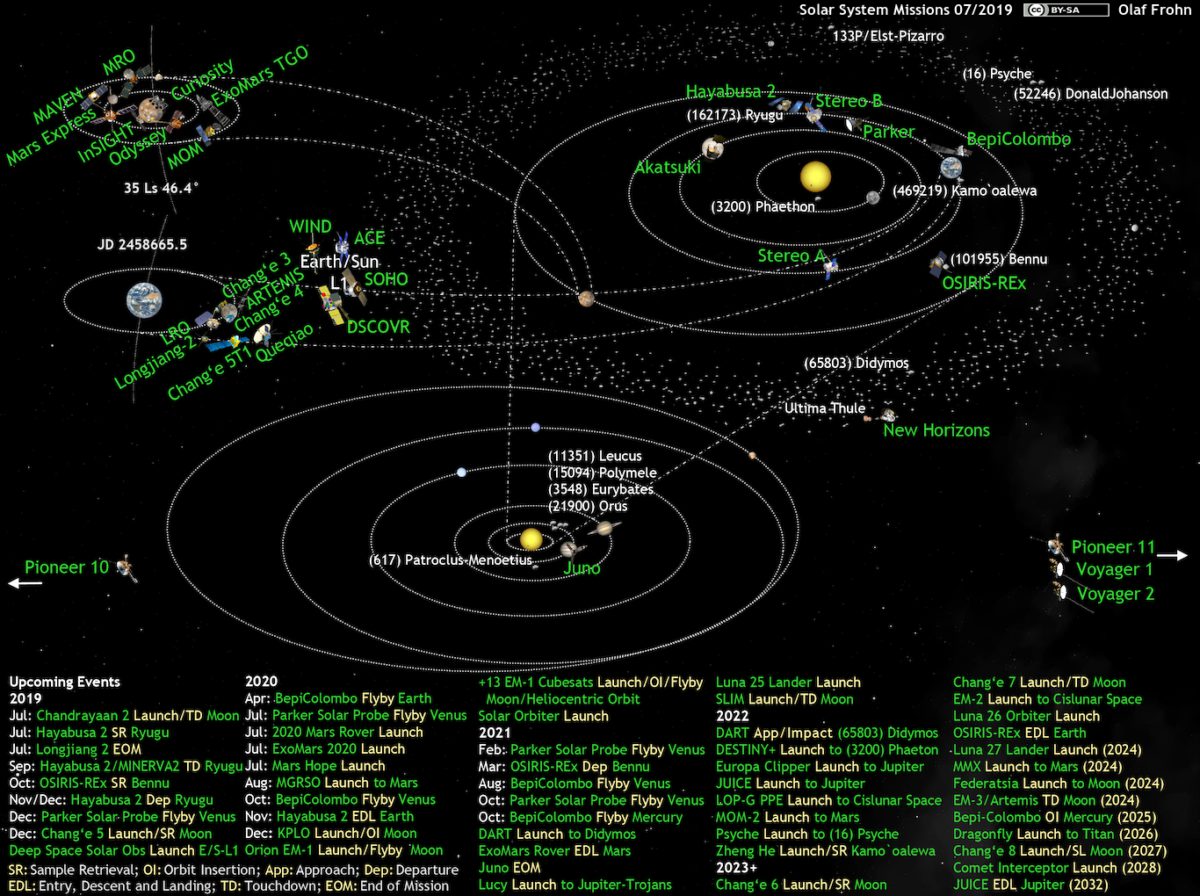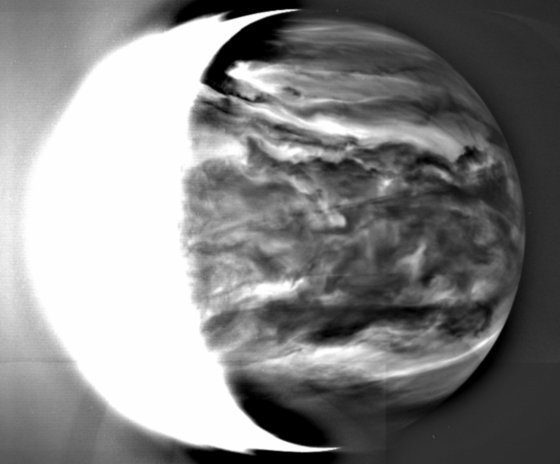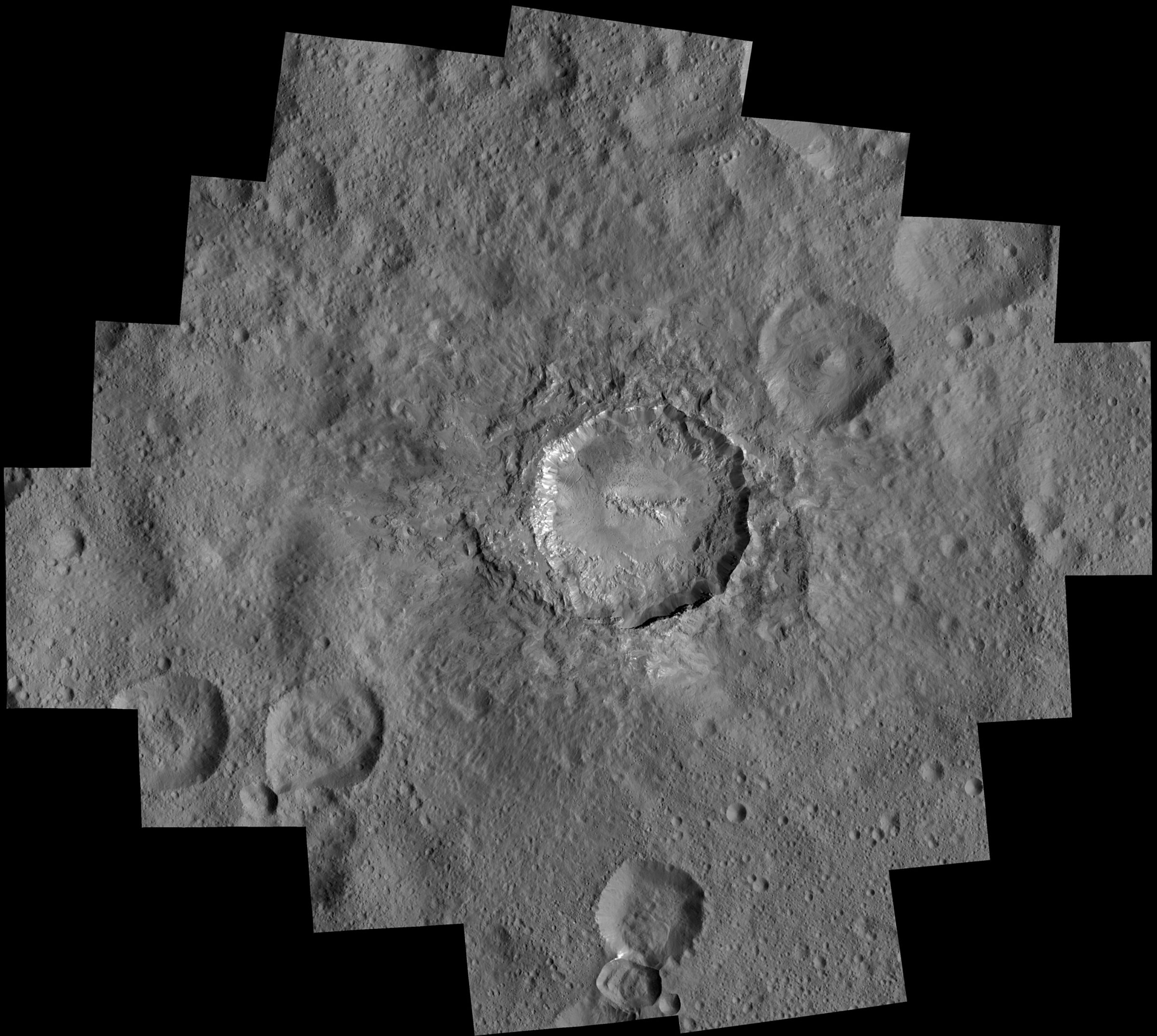Emily Lakdawalla • May 03, 2016
What's up in the solar system, May 2016 edition: Good news in cruise for Juno and ExoMars Trace Gas Orbiter
May 2016 will be yet another month of fairly routine operations across the solar system -- if you can ever use the word "routine" to describe autonomous robots exploring other planets. I count 19 spacecraft carrying out 17 active science missions: Akatsuki, Lunar Reconnaissance Orbiter, Chang'e 3, possibly Chang'e 5 T1, ARTEMIS, Odyssey, Opportunity, Mars Express, Mars Reconnaissance Orbiter, Curiosity, Mars Orbiter Mission, MAVEN, Dawn, Rosetta, Cassini, New Horizons, and the Voyagers. Meanhile, Hayabusa2, ExoMars Trace Gas Orbiter, and Juno are cruising toward their destinations. ExoMars' cruise to Mars has started smoothly, and Juno is only two months away from Jupiter orbit insertion, this summer's most anticipated event. Closer to home, many of us stuck on Earth will have an opportunity to witness a rare transit of Mercury across the Sun on May 9. And sometime soon, the world should receive the first public release of data from the Pluto encounter phase of the New Horizons mission.
Before I get into further detail, here's Olaf Frohn's summary diagram:

Earth Launches and Landings (contributed by Jason Davis)
May marks the last full month in space for Tim Kopra, Tim Peake and Yuri Malenchenko, three Expedition 47 crew members who launched to the International Space Station back in December. The trio recently received a two-week mission extension to June 18. Also currently aboard the station is NASA astronaut Jeff Williams, as well as cosmonauts Oleg Skriprochka and Alexey Ovchinin. The crew has started packing return cargo into SpaceX's CRS-8 Dragon, which arrived April 10. Dragon departs on May 11 and will splash down in the Pacific Ocean. Also potentially leaving this month is Orbital ATK's OA-6 Cygnus cargo craft, which arrived March 26. After Cygnus is released, an experiment called Saffire-1 will ignite a controlled fire aboard the spacecraft before it reenters Earth's atmosphere. Either later this month or in early June, flight controllers may inflate BEAM, the expandable habitat that was attached to the station's Tranquility module last month.
United Launch Alliance Atlas V flights remain grounded while the company troubleshoots an engine anomaly that occurred during the OA-6 launch. The only other U.S. launch scheduled this month is a SpaceX Falcon 9, which launches the JCSAT-14 communications satellite from Cape Canaveral in the early hours of May 5. Because the rocket is making a high-energy trip to geostationary transfer orbit, SpaceX is opting for another drone ship landing at sea.
At least three international launches are planned in May, according to schedules posted at Spaceflight Now and RussianSpaceWeb. A Soyuz rocket launches a Russian navigation satellite from the Plesetsk Cosmodrome on May 21. Three days later, another Soyuz blasts a pair of European navigation satellites into orbit from French Guiana. Finally, on May 28, a Proton rocket carries a commercial communications craft into space from Baikonur.
Inner Solar System
Akatsuki is finally in its science orbit, doing science! I'm planning a more detailed update on what Akatsuki is doing; in the meantime, here's a lovely photo of nightside clouds taken with an infrared camera. From its long orbit Akatsuki should be able to get lots of photos like this, watching cloud dynamics.

Earth's Neighborhood
Lunar Reconnaissance Orbiter is still actively exploring the Moon. Last month they issued a press release about new work based on Lunar Reconnaissance Orbiter data on lunar swirls, odd features thought to be related to magnetized lunar crust that interacts with the solar wind. What I thought was most interesting about the release is that the lead authors on the two newest papers -- Brett Denevi and Amanda Hendrix -- are women who I think of as working on other worlds (Brett on Mercury, and Amanda on Saturn's icy moons). It's pretty neat, in planetary science, how experience with working on certain kinds of physics or observation techniques on one world can take you to totally different parts of the solar system.
I don't have any updates on ARTEMIS beyond what I wrote in February, or on Chang'e 3 or Chang'e 5 T1 since April.
Near-Earth Asteroids
On March 22, Hayabusa2 began continuous operation of its ion engines to adjust its orbit to match that of asteroid Ryugu. The first period of ion thrusting is supposed to finish in the middle of this month. There will be two more thrust periods between now and its June or July 2018 arrival at Ryugu. A little more information is available on the JAXA "fanfun" site. Also, here's a nice interactive visualization tool showing Hayabusa2's position in the solar system. Hayabusa2 is presently more than 25 million kilometers away from Earth (and growing farther away); and fewer than 106 million kilometers away from Ryugu (and getting closer). Watching the numbers tick by, it looks like it's currently closing the distance to Ryugu at about 6.5 kilometers per second. As Hayabusa2 travels farther from the Sun and as they work to adjust its orbit to match Ryugu's, that closing rate will decrease.
On the Way to Mars
ExoMars Trace Gas Orbiter is having a smooth cruise, so far. A few weeks ago ESA reported that all the navigation and communication systems have been checked out and are now in operation. The high-resolution camera, CaSSIS, was turned on on April 7, capturing a pair of "first light" images of a nondescript portion of space. A trajectory correction maneuver is planned for July. Orbit insertion will be on October 19; Schiaparelli will land on the same day. Here's an overview of what to expect on arrival day. ESA released a video update this morning:
Mars
Mars Odyssey celebrated its 15th launch anniversary in April; its 15th arrival anniversary is coming up on October 24. I wrote a blog post about their new morning imaging with THEMIS last month; you can see the results of those morning images on the THEMIS website.
There was little news from Mars Express this month. The Mars Webcam has been active, with the most recent images dating to April 28.
Mars Reconnaissance Orbiter has been quiet, too. The latest weather report from MARCI includes "local dust storms observed across many regions of the southern hemisphere" and "At low latitudes, diffuse water-ice clouds associated with the aphelion cloud-belt persisted through each afternoon." Don't forget to check the HiRISE website regularly for image updates. I have a lot of favorites this month, including a dramatically lit view of some gullies, and the awesome faulted layers in the walls of some collapse pits.
I just realized that I've been neglecting to include Mars Orbiter Mission in these updates. Unfortunately, I don't have any information on its recent status. A news release from the mission yesterday concerned a paper that was released in March, and the official Twitter and Facebook pages have been quiet since December. I hope someday to see public release of archival data from its color camera!
MAVEN performed an orbital trim maneuver on April 10, the first in 77 days. Its periapsis was raised to 164.5 kilometers -- still much lower than the circular orbits of the other NASA orbiters. At that altitude, Mars' atmopheric density is 70 grams per cubic kilometer, which is pretty sparse, but enough for a spacecraft's orbit to slowly decay. MAVEN's next two deep-dip campaigns are planned for early June and late July of this year.
In the first half of April, Opportunity's science and engineering teams conducted a "mini walkabout" of Marathon valley, looking for sites for in-situ investigation. It's now investigating the first of those sites, "Pierre Pinaut," but has been slowed down a bit by a couple of anomalies with the Microscopic Imager. Things seem to be okay, though, and the power situation is very good, with more than 600 watt-hours being generated all month. The latest atmospheric opacity number is heading upward, though, which I hope is not a warning of dustier skies in May. Check out these and other updates at the Opportunity website.
On the other side of Mars, Curiosity has still not quite crossed the Naukluft Plateau because the team decided to drill into a silica-rich halo in the Stimson rock unit at a site called Lubango before they finished the crossing. Curiosity drilled its 10th hole on Mars last week, and has just driven to a new site named Ovitoto to sample some Stimson rock outside a halo. Once they complete the next drill hole, they should be back on the road.
Beyond Mars
Rosetta's science is getting better all the time as it continues to watch comet Churyumov-Gerasimenko change. Last month, the mission released some maps showing how the color of the comet changed between August and November of 2014. No previous mission has orbited a comet, and no previous comet has been seen by a spacecraft more than twice, so Rosetta's long-term survey is going to be scientifically revolutionary. Meanwhile, the formal release of Navcam images has slowly but steadily been catching up with the present, and the latest Navcam image releases were taken only 6 weeks ago. That's pretty extraordinary. The Rosetta mission will come to an end in only 5 months, at the end of September.
Dawn is now orbiting Ceres at the lowest altitude it'll ever achieve: an average 385 kilometers. Last month, principal investigator Chris Russell told reporter Govert Schilling that the mission was considering targets beyond Ceres for an extended mission, surprising many (by which I mean to say, this was a huge surprise to me). The latest Dawn Journal reports that Dawn's remaining two reaction wheels continue to work fine and that the mission has done a good job husbanding hydrazine, but the remaining fuel is still expected to last only partway through 2017 even if the reaction wheels stay 100% healthy. Check the Photojournal for the latest images! Here's a lovely photo mosaic of Haulani crater:

Juno is now just 63 days and about 38 million kilometers from Jupiter. Amateur astronomers continue to pour images into the JunoCam image database to help the team plan future imaging. Jupiter was at opposition in March, so the quality of amateur astronomer images peaked then; images are still excellent now, but as we approach summer, the quality of Earth-based Jupiter images will be declining precipitously. Junocam is not a very high-resolution camera, but after orbit insertion for a couple of months, its images will be better than the ones we can get from Earth.
Cassini is just about at periapsis of Rev 235, headed for its 120th flyby of Titan. This flyby is devoted to a radio occultation experiment, where Cassini will watch radio signals from Earth pass through Titan's atmosphere. Closest approach happens at a close altitude of 971 kilometers. (Cassini does closer flybys of other icy moons, but Titan's atmosphere keeps Cassini at arm's length.) The flyby will also boost the inclination of Cassini's orbit from 27.8 to 35.3 degrees. The Cassini mission website has just been redesigned, and the new version of the raw images page has better filtering than it did previously.
New Horizons has downlinked quite a lot of good LORRI data from the "core" phase of the encounter in the last month, including several new views of Hydra and Nix, while also filling in much more of the Pluto and Charon approach sequence. Visit my LORRI data summary page and look for the yellow-highlighted images to see all the new stuff. This one is one of the last that New Horizons took showing Pluto and Charon in the same LORRI frame, a high-resolution view of the face of Pluto we didn't see up close during the flyby. Meanwhile, I'm eagerly awaiting the first release of data from New Horizons to the Planetary Data System; my understanding was that they were supposed to release data returned to Earth as of July 31, 2015 in April, but I haven't seen the data release yet. The data should show up at the Small Bodies Node of the PDS and possibly also at the Ring-Moon Systems Node. There have been two nice blogs on geologic mapping of Pluto published in the last month, one by Oliver White and one by Ross Beyer. Check their science images gallery for the latest interpretation of New Horizons images!
Finally, the Voyagers are still going, going, going. Voyager 1 is at 134.9 AU from the Sun, and Voyager 2 is at 111.1 AU.
Let’s Go Beyond The Horizon
Every success in space exploration is the result of the community of space enthusiasts, like you, who believe it is important. You can help usher in the next great era of space exploration with your gift today.
Donate Today

 Explore Worlds
Explore Worlds Find Life
Find Life Defend Earth
Defend Earth

